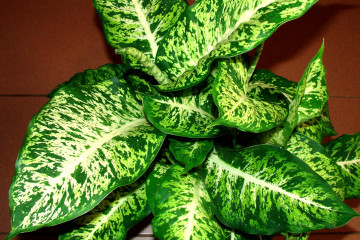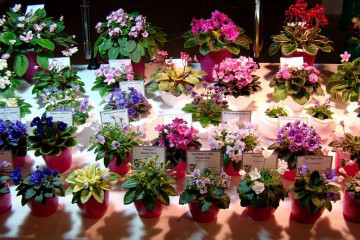Why do dracaena leaves turn yellow - reasons
Content:
Dracaena is a popular potted plant that is grown not only in apartments, but also in offices and public buildings. The flower is unpretentious to care for, but if the rules are not followed, its leaves may begin to turn yellow. To fix the problem, you need to know the reasons for its occurrence.
Dracaena leaves turn yellow and fall - what could be the reasons

Dracaena is a beautiful tropical plant, unpretentious in care
Dracaena has another name - "palm" due to its unusual exotic appearance. She often becomes an interior decoration. But sometimes owners may be faced with a situation where the leaves of the plant begin to turn yellow. There may be several reasons, ranging from damage by pests to natural aging of the plant. Often, even with high-quality and proper care, the problem cannot be avoided.
The most common reasons why dracaena leaves turn yellow are:
- Physiological aging of the plant. The lower leaves of the flower begin to turn yellow and die off - this is considered a normal process. If the plant has a tall, elongated stem, the main stem should be cut off so that new stems can grow.
- A lot of moisture. Improper watering can cause yellowness on the leaves. Too moist soil, improperly organized drainage lead to the development of rot, because of this, the plant's immunity weakens. To fix the problem, you need to water the plant once a week. This will help improve its condition and color.
- Insufficient watering. This factor also has a significant effect on the state of the leaves of the plant. It is a tropical flower that thrives in humid conditions. Dry air in an apartment has a negative effect on it. The problem is especially aggravated in winter, when the heating is turned on in the apartments. The plant needs regular spraying, in winter you need to carry out this procedure daily. Next to the pot in which the dracaena grows, you can put a container with water. This will help to increase the humidity in the room.
- Direct sunlight. They are harmful to the plant as they can cause burns. It is important that the place for the pot is chosen correctly. Dracaena really needs daylight, but at the same time it must be protected from the sun.
- Lack of light. If the plant stands in a place where there is low light, the leaves begin to turn yellow from below, then fall off. Sometimes the phenomenon is observed if the light hits only half of the plant. Therefore, it is recommended to turn the pot regularly.
- Defeat by a virus. In this case, yellowing will be the first sign. In addition, deformation of the foliage and stem will begin. Infections are highly contagious and can infect all plants in the home.
- Flower attack by pests. Yellowing of the leaves can be caused by parasites such as spider mites, scale insects, thrips. In addition to the yellowness of the leaves, additional symptoms appear in the form of brown spots on the stems and thin white stripes on the leaves. Pests suck out the juice from the plant, because of this, the weakened leaves begin to turn yellow and fall off.
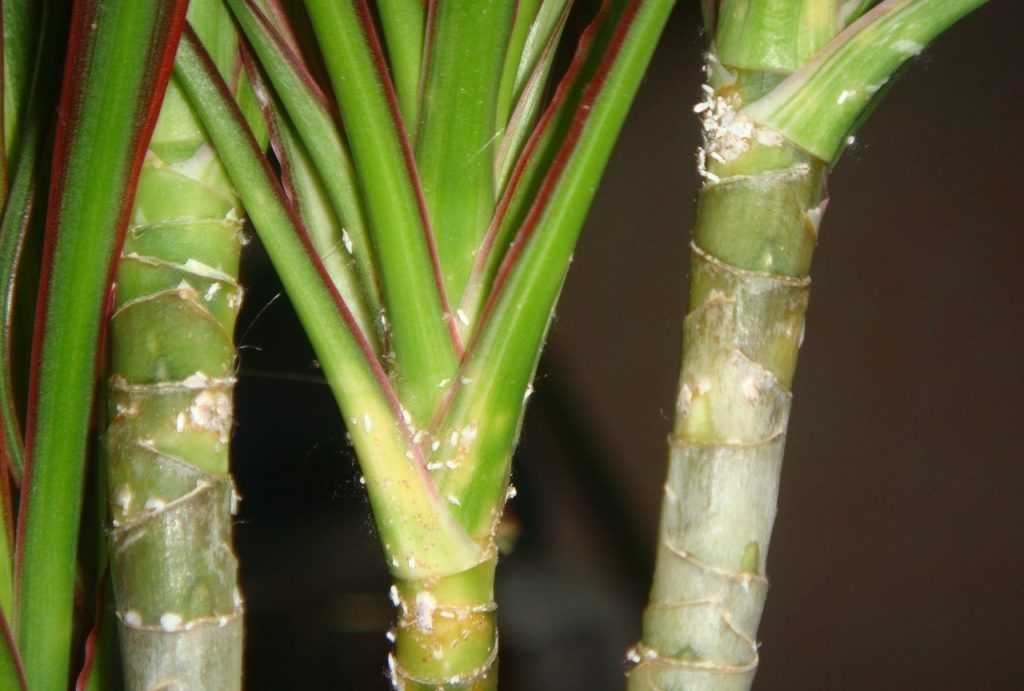
One of the reasons for the yellowing of leaves may be an attack of a flower by parasites.
Diseases
A yellowish tint on dracaena foliage most often occurs due to a disease of the plant. It is very difficult to tolerate sudden changes in temperature. If you move a flower from the street to a very hot room, then the edges of the leaves will begin to crack.
The plant begins to hurt even if it has been in the sun for a long time. Direct rays cause burns. But the lack of light is also detrimental to tropical culture. This leads to fading of foliage, it becomes weak in color.
Dracaena are often exposed to infectious diseases. In this case, the following symptoms will additionally appear as symptoms:
- slowdown in plant growth;
- yellowing of the leaves, and then their falling off.
Infectious diseases are transmitted from other plants or introduced into the soil by tools when loosening. If the symptoms are ignored, the flower may die.
The appearance of dark brown spots on the tips of the leaves indicates the development of a bacterial infection. The stem may turn black at the base, then begin to rot around the petioles. An unpleasant odor appears. If the infection is mild, it is possible to remove the diseased foliage and then spray it with a growth stimulant. These measures will reduce the development of pinpoint disease.
Plant owners may encounter fungal infections. As symptoms, yellowing will appear on the leaves, small brown spots with a red edging, fungal spores will become noticeable on the top of the spots.
If dracaena is affected by a fungus, it is necessary to remove diseased leaves, stop spraying the plant. Then treatment with a series of biological products should be carried out.
Another infectious pathology that a tropical plant is susceptible to is Fusarium spotting. When infected with it, leaf rot is observed in the flower, watery spots with a yellow edging appear on the plates.
The plant will begin to dry and shed its leaves if mold appears in the ground. Many indoor flowers are susceptible to this phenomenon. Most often, the problem occurs due to improper care. Poor soil quality, inadequate lighting, high humidity levels all lead to mold formation. You can save the dracaena only if you transplant it into new soil with drainage. It is important that the soil is loose.
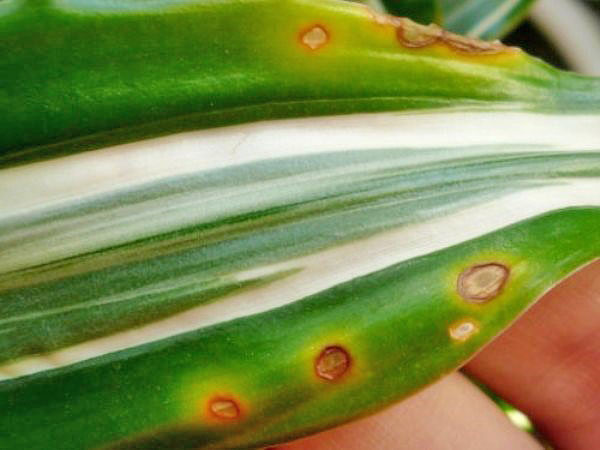
Dracaena infectious diseases are manifested by yellowness on the leaves and the appearance of brown spots.
Pests
If you do not properly care for a tropical flower, it can be attacked by parasites. They begin to suck the juices from the leaves, later the dracaena can fall off and completely die.
The following types of pests are dangerous for dracaena:
- Thrips. One of the most dangerous parasites that attack indoor flowers. It settles from below on the leaves, and feeds on cell sap. The yellowing of the foliage is due to the fact that the female parasites gnaw through the foliage tissue. This provokes her fall. Thrips reproduce actively at high indoor temperatures. To get rid of the problem, you can spray with soapy water. After the procedure, the flower must be covered with polyethylene. The preparations "Iskra" and "Fitoverm" help to destroy parasites well.
- Shield. A common parasite on indoor flowers. It got its name from a small flap on the back (this is a protective layer). The female is able to lay a large number of larvae, which are tightly attached to the surface of the leaves, and suck out the juice. Affected dracaena stops growing, its leaves turn yellow. Processing should be carried out with methyl alcohol. It is gently applied with a sponge to the affected areas. As soon as the pests are weakened by the action of the drug, they are finally removed with the help of the drug "Inta-SM", "Aktara". The yellow leaves are completely removed.
- Mealy bugs. This is an insect covered with white bloom on top. Thanks to this, it is very clearly visible on the leaves. When infected, the flower stops developing. On the surface of the leaves, white waxy traces are formed from the movement of the parasite. They can be removed with a toothbrush and soapy water. With a strong degree of damage, the preparations "Fitoverm" or "Akhtar" are used.
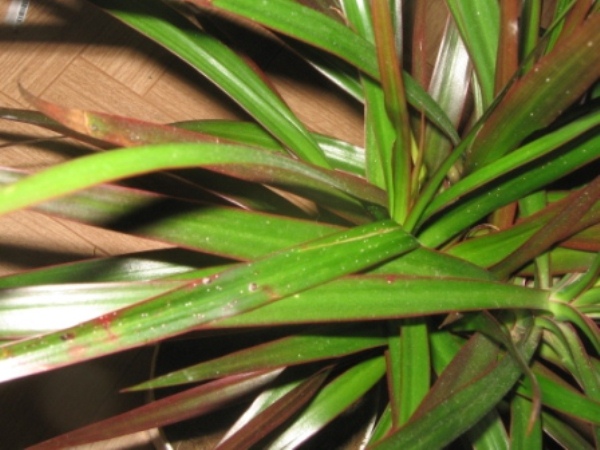
Most often, the owners of dracaena are faced with damage to the scabbard.
Soil moisture
Dracaena is a flower native to tropical countries. It thrives on a combination of heavy rainfall and long-term drought. This feature of the climate led to the fact that dracaena developed resistance to irregular watering. Problems can arise if the flower is constantly in a humid environment.
Experts recommend watering the dracaena by immersion. To do this, you can take a large container in which the pot will fit. There should be enough water in the container so that it reaches the level of the ground in the pot. The flower is kept in this position for about 10 minutes. Then you need to remove the pot from the container with water, put it so that all excess moisture can drain off. The next watering is necessary only when the soil is completely dry. There is an easy way to check this. You need to deepen your finger 5 cm into the ground. If it is dry and loose, you can water it.
For proper growth, dracaena must be watered once a week. In winter, the procedure is needed less often, since the flower will be at rest. Just regular spraying will be enough for him.
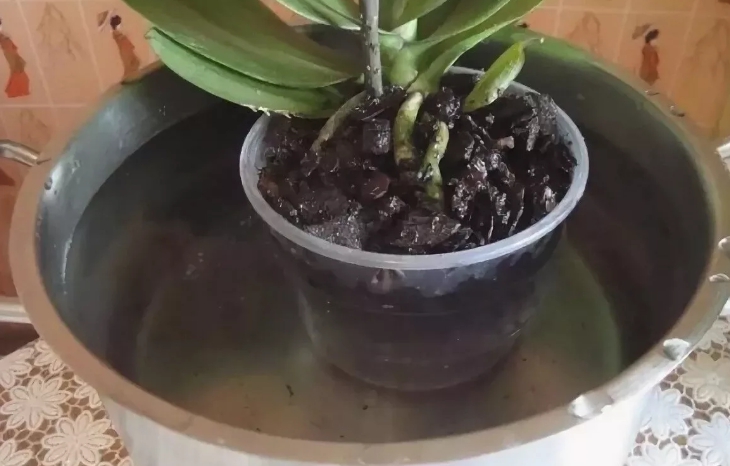
The best way to irrigate is by immersion
Air temperature
The tropical plant is very thermophilic. It is recommended that the temperature in the room where it stands is at least 25 degrees. Very low temperatures can kill the flower. The location for the dracaena should be chosen light, but direct sunlight should not fall on it.
Decay of roots
Dracaena may turn yellow if its roots begin to rot. This is due to an excess of moisture in the soil. The owner of the plant can find out that the ground is damp on his own. To do this, you need to deepen your finger a few centimeters into the soil. The soil will be damp with a moldy smell. If mulch is used, then with an excess of moisture, it will turn black. Also, a large amount of water is indicated by its stagnation in the container under the pot.
To avoid root rot, you need to make a good drainage layer. It will control the moisture level of the soil. When transplanting a plant, drainage is always laid out with a new layer.
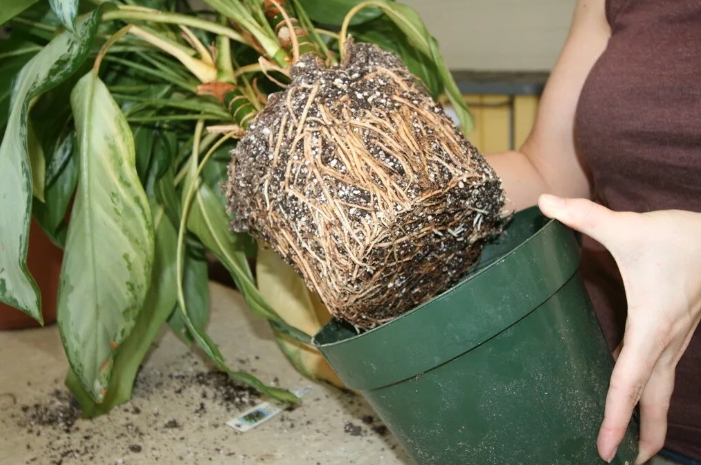
If the root rot is the cause of the yellowing of the leaves, the plant can only be saved by transplanting it into a new soil.
Other possible problems
Most often, the leaves of dracaena turn yellow due to improper care. Excessive or, conversely, too poor watering can lead to the death of the flower. But there are other reasons that provoke the yellowness of the leaves. These include:
- Drafts and low room temperatures. The heat-loving flower comes from hot countries, so it is hard to tolerate the cold. You can not put the pot next to the air conditioner, open windows. If the flower is in drafts, pale yellow spots form between the veins on the leaves.
- Regular transplant. For abundant growth and dense foliage, dracaena needs regular transplantation. If yellowing is noticeable on the leaves, they become stained, and begin to fall off, you need to change the ground. Dracaena does not like soil over three years old. Salts begin to accumulate in it, which do not allow nutrients to enter the main flower.In order for the plant to grow actively and feel good, it is recommended to replant it every two years in the spring. To keep the soil loose, you need to add charcoal and sand to it. In addition to regular replanting, every year the topsoil is changed to a new one.
- Lack of nutrients. The symptom will be the appearance of yellowness on the upper leaves of the plant. Most often this is a signal that there is a lot of calcium in the earth or a lack of nitrogen. In such a situation, nitrogen fertilizers will help. You also need to replace the water that is being irrigated. In addition, the plant will begin to die if the soil is very hard.
- Improper use of fertilizers. If there is an excess of nitrogen in the soil, the leaves will begin to fall off. Often they do not even have time to turn yellow.
Dracaena belongs to the plant species that are very popular with gardeners. A beautiful flower will be a great decoration for any room. If you provide him with the right care, he will delight you with fresh and bright foliage for a long time. The first shedding of leaves is observed only after two years. In such a situation, it will be a natural process. An active yellowing of the entire plant, leaf fall, and the appearance of additional symptoms should cause anxiety. It is important to establish the cause in a timely manner and take all possible measures to save the flower.
